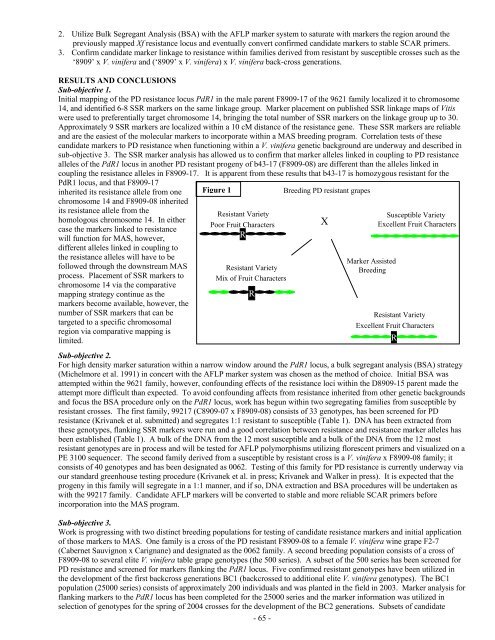Impact Of Host Plant Xylem Fluid On Xylella Fastidiosa Multiplication ...
Impact Of Host Plant Xylem Fluid On Xylella Fastidiosa Multiplication ...
Impact Of Host Plant Xylem Fluid On Xylella Fastidiosa Multiplication ...
Create successful ePaper yourself
Turn your PDF publications into a flip-book with our unique Google optimized e-Paper software.
2. Utilize Bulk Segregant Analysis (BSA) with the AFLP marker system to saturate with markers the region around the<br />
previously mapped Xf resistance locus and eventually convert confirmed candidate markers to stable SCAR primers.<br />
3. Confirm candidate marker linkage to resistance within families derived from resistant by susceptible crosses such as the<br />
‘8909’ x V. vinifera and (‘8909’ x V. vinifera) x V. vinifera back-cross generations.<br />
RESULTS AND CONCLUSIONS<br />
Sub-objective 1.<br />
Initial mapping of the PD resistance locus PdR1 in the male parent F8909-17 of the 9621 family localized it to chromosome<br />
14, and identified 6-8 SSR markers on the same linkage group. Marker placement on published SSR linkage maps of Vitis<br />
were used to preferentially target chromosome 14, bringing the total number of SSR markers on the linkage group up to 30.<br />
Approximately 9 SSR markers are localized within a 10 cM distance of the resistance gene. These SSR markers are reliable<br />
and are the easiest of the molecular markers to incorporate within a MAS breeding program. Correlation tests of these<br />
candidate markers to PD resistance when functioning within a V. vinifera genetic background are underway and described in<br />
sub-objective 3. The SSR marker analysis has allowed us to confirm that marker alleles linked in coupling to PD resistance<br />
alleles of the PdR1 locus in another PD resistant progeny of b43-17 (F8909-08) are different than the alleles linked in<br />
coupling the resistance alleles in F8909-17. It is apparent from these results that b43-17 is homozygous resistant for the<br />
PdR1 locus, and that F8909-17<br />
inherited its resistance allele from one<br />
chromosome 14 and F8909-08 inherited<br />
its resistance allele from the<br />
homologous chromosome 14. In either<br />
case the markers linked to resistance<br />
will function for MAS, however,<br />
different alleles linked in coupling to<br />
the resistance alleles will have to be<br />
followed through the downstream MAS<br />
process. Placement of SSR markers to<br />
chromosome 14 via the comparative<br />
mapping strategy continue as the<br />
markers become available, however, the<br />
number of SSR markers that can be<br />
targeted to a specific chromosomal<br />
region via comparative mapping is<br />
limited.<br />
Figure 1<br />
Resistant Variety<br />
Poor Fruit Characters<br />
R<br />
Resistant Variety<br />
Mix of Fruit Characters<br />
R<br />
Breeding PD resistant grapes<br />
Resistant Variety<br />
Excellent Fruit Characters<br />
R<br />
Sub-objective 2.<br />
For high density marker saturation within a narrow window around the PdR1 locus, a bulk segregant analysis (BSA) strategy<br />
(Michelmore et al. 1991) in concert with the AFLP marker system was chosen as the method of choice. Initial BSA was<br />
attempted within the 9621 family, however, confounding effects of the resistance loci within the D8909-15 parent made the<br />
attempt more difficult than expected. To avoid confounding affects from resistance inherited from other genetic backgrounds<br />
and focus the BSA procedure only on the PdR1 locus, work has begun within two segregating families from susceptible by<br />
resistant crosses. The first family, 99217 (C8909-07 x F8909-08) consists of 33 genotypes, has been screened for PD<br />
resistance (Krivanek et al. submitted) and segregates 1:1 resistant to susceptible (Table 1). DNA has been extracted from<br />
these genotypes, flanking SSR markers were run and a good correlation between resistance and resistance marker alleles has<br />
been established (Table 1). A bulk of the DNA from the 12 most susceptible and a bulk of the DNA from the 12 most<br />
resistant genotypes are in process and will be tested for AFLP polymorphisms utilizing florescent primers and visualized on a<br />
PE 3100 sequencer. The second family derived from a susceptible by resistant cross is a V. vinifera x F8909-08 family; it<br />
consists of 40 genotypes and has been designated as 0062. Testing of this family for PD resistance is currently underway via<br />
our standard greenhouse testing procedure (Krivanek et al. in press; Krivanek and Walker in press). It is expected that the<br />
progeny in this family will segregate in a 1:1 manner, and if so, DNA extraction and BSA procedures will be undertaken as<br />
with the 99217 family. Candidate AFLP markers will be converted to stable and more reliable SCAR primers before<br />
incorporation into the MAS program.<br />
Sub-objective 3.<br />
Work is progressing with two distinct breeding populations for testing of candidate resistance markers and initial application<br />
of those markers to MAS. <strong>On</strong>e family is a cross of the PD resistant F8909-08 to a female V. vinifera wine grape F2-7<br />
(Cabernet Sauvignon x Carignane) and designated as the 0062 family. A second breeding population consists of a cross of<br />
F8909-08 to several elite V. vinifera table grape genotypes (the 500 series). A subset of the 500 series has been screened for<br />
PD resistance and screened for markers flanking the PdR1 locus. Five confirmed resistant genotypes have been utilized in<br />
the development of the first backcross generations BC1 (backcrossed to additional elite V. vinifera genotypes). The BC1<br />
population (25000 series) consists of approximately 200 individuals and was planted in the field in 2003. Marker analysis for<br />
flanking markers to the PdR1 locus has been completed for the 25000 series and the marker information was utilized in<br />
selection of genotypes for the spring of 2004 crosses for the development of the BC2 generations. Subsets of candidate<br />
- 65 -<br />
X<br />
Marker Assisted<br />
Breeding<br />
Susceptible Variety<br />
Excellent Fruit Characters











